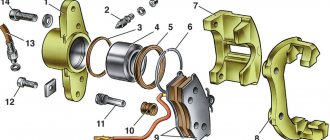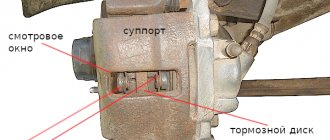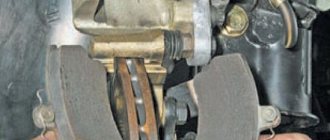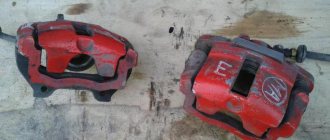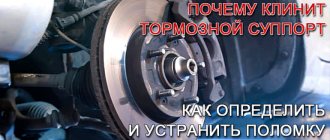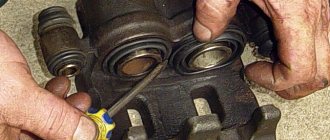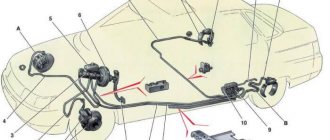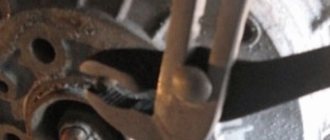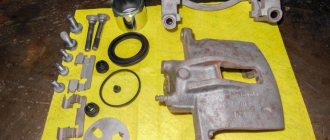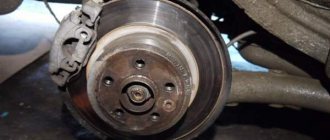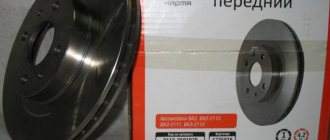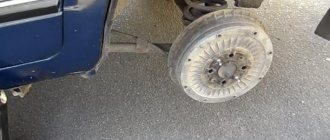If you notice that the car noticeably pulls to the right or left when braking, and after releasing the brake pedal the front wheels (wheel) remain blocked, the brake discs overheat or there is a feeling that they are deformed - then the signs of a faulty brake caliper are obvious, and you should pay close attention to the VAZ disc brake caliper . In particular, its pistons, cylinders and guides deserve special attention.
It is worth considering that similar brake caliper malfunctions can be caused by other reasons. Here is their list:
- Severe wear on the brake pads.
- Brake master cylinder malfunction.
- Presence of air pockets in the hydraulic drive of the brake system.
- Damage to the brake disc.
Therefore, to localize the fault, you must first make sure that all other components are in order and bleed the brake system. Next, you will learn how to check the caliper guides.
How to avoid caliper failure
The procedures described above for completely cleaning the caliper are very complex and require a lot of time. To ensure that they are carried out as rarely as possible, be sure to lubricate the caliper surface with special grease or WD-40 every 6 months to avoid corrosion.
It is also recommended to inspect the caliper annually for corrosion, damage, dirt, and boot rupture.
Welcome! Brake cylinders - thanks to them, braking is carried out, and without the pistons that are in them, these cylinders will not work at all, so if a piston fails, then you have to go to a car store and buy a new brake cylinder, because driving without brakes is scary and even more dangerous , but not in all cases the pistons stop working forever, sometimes they can be revived, and we will write in detail about how to do this in this article.
Note! To work, you will need to stock up on: A jack to lift any side of the car, as well as a wheel wrench and you may also have to stock up on bricks, and you may also need a basic set of wrenches and sockets!
Summary:
How to understand that the pistons of the brake cylinder are not working? Let us answer this question before we move on to the repair of pistons, namely inoperative (That is, the pistons do not move in the cylinder), the pistons are recognized if they do not move at all and stand in one place, as a result of which the car, namely the brakes, begins a number of problems occur, that is, the car cannot drive normally because it constantly slows down even though you don’t press the brake pedal at all, or it may be that the car will drive but it will brake much worse than it should, in general, let’s figure it out Why do these cylinder pistons fail?
From time to time, the sealing ring (indicated in the photo below by an arrow) that fits the piston in a circle either wears out, or micro cracks form in it through which dirt begins to get into the piston itself, where the lubricant is located, and as a result the piston becomes unusable.
And also, the piston can simply sour in the brake caliper, and this can happen because of our roads, which in winter are mostly sprinkled with sand and salt, and the brake system is located in the very bottom of the car and therefore is subject to heavy braking. and in general, when moving, all this salt flies which little by little brings the situation to the point where the piston simply rusts, otherwise it simply sours, and therefore it will then be very difficult to move it from its place and thus it stops moving and therefore stops working.
By the way, you can very easily understand if your piston is somehow soured, if your car’s fuel consumption on the highway increases, and also if the car, as already mentioned earlier, starts to drive worse, and also if you notice that In neutral gear, the car began to slow down a little, this can also be understood if the car begins to skid on a winter road from braking, all this indicates that your piston has stopped working.
Why don't the front wheels release the brakes? 9 popular reasons »
What to do if the front wheels do not release the brakes? First of all, look for the reason. There can be quite a lot of them, and the symptoms are the same for all, although some differences exist. If you are not very smart about hardware, it is easier to go to a service station and give your car into the hands of a professional auto mechanic. If you are no stranger to communicating with technology, you can figure it out yourself. Just keep in mind: you may need to spend quite a lot of time and sometimes you will have to climb quite far.
After all, both the reasons themselves and their symptoms can indicate various problems, although mainly related to the brake system. And brakes are a serious thing: poor wheel release can lead to very disastrous consequences if the cause is not eliminated in time.
The front wheels do not release the brakes in different ways:
sometimes they jam completely (in this case, further driving is simply impossible), sometimes they scroll, but with some tension and with a creak (and that’s when some drivers may try to drive for a while, and this can be fraught). And it happens that only one wheel is stuck, and the second one turns without any problems. In any case, you will have to dig deeper.
Both wheels won't release
. The diagnosis is sad, because this did not just happen, but had been accumulating for some time. So, most likely, you will have to change not only it, but also the pads - during the abnormal operation they have probably been worn down to zero. The costs will be significant, but you can save money if you can change it yourself. However, everything may not be so sad: the caliper may be intact, but skewed. In this case, the position is leveled out and the wheels begin to release the brakes again.
The compensation hole on the brake master cylinder is clogged. There is a lot of fuss, the work is dirty, you will have to disassemble almost the entire assembly, but there are no expenses for spare parts. Read the article "" for more details.
Pistons and wheel brakes are jammed
, and the master cylinder. Only those who regularly delve into their cars will be able to find out the reason on their own. Sound advice is to go to a service center and only after finding out the cause decide whether you can fix it or let the experts repair it. Often the problem is solved by cleaning and lubrication.
Be sure to check all hoses
. It is not uncommon for the clamp that secures the hose to corrode and compress it. If this reason is suspected, the clamp should be released (and ideally replaced) and the hose itself should be blown out.
One of the wheels does not release the brakes
In this case, there may be an accompanying symptom - strong heating of the wheel rim. Problems that arise here are usually easier to solve.
- The tension spring on the brake pads is not in order
. Moreover, it did not necessarily burst, it could simply weaken. However, it will still have to be changed: no one has canceled metal fatigue; if the spring is stretched, it will no longer work normally; - The problem is in the friction lining, again on the brake pad. It is either damaged, torn off, or worn down to an unacceptable thickness. Often it is changed along with the pad, especially when it wears out, since it also suffers in this process. Moreover, when replacing the friction lining, you will also have to change the pair, otherwise there is a high probability of the car drifting off the trajectory due to varying degrees of wear;
- The piston jammed, this time in the corresponding wheel brake cylinder. Check, clean, lubricate, if necessary, replace;
- The cuffs on the wheel cylinder are swollen or deformed. Change it and the problem will go away as if it never happened. In fact, it’s best to check the cuffs at least occasionally. And change - at any disassembly, even if they look intact and not distorted;
- There is no gap between the drum and the friction linings;
- The guides are oxidized
. After cleaning and lubricating them, the wedge will not reoccur.
How to turn an inoperative brake cylinder piston into a functional one?
1) At the very beginning of the operation, you will need to remove the wheel from the car.
Note! By the way, when you remove the wheel from the car, try to spin it while it is in the air; if it slows down, then some piston has actually become unusable!
2) After your wheel is removed, immediately remove the caliper from the car after it in order to get out the brake piston that is not working. (For information on how to remove the brake caliper on front-wheel drive cars, see the article: “Replacing the brake caliper on a VAZ 2109”, and for information on how to remove this caliper on a classic, see “this article”)
3) Now, when the caliper is removed from the car, you will need to find a vice, or a very strong compressor, in order to remove the piston from the brake cylinder, so if you have a vice, then go to it and clamp the piston itself and behind the caliper after Once you clamp the piston, pull it, and thereby the piston will be removed from its installation location.
Note! If you don’t have a vice, then pick up a compressor or something else where air can come out under pressure and thereby insert the hose from the compressor into the small hole in the caliper, namely where you connect the brake hose itself and then turn on the compressor and the piston will fly out of its installation location!
4) Next, take the removed piston in your hands and inspect it, if you find traces of rust on it as shown by the arrow in the photo below, then they will have to be removed using some kind of chemical or something else (A good example of cleaning the piston from rust, shown in one of the videos below), and after the rust has been removed, also inspect the brake caliper itself and finally reassemble all previously removed parts in the reverse order of removal and at the very end check their functionality.
Note! Still, a new piston is not too expensive in the store for our domestic cars, so if you have the opportunity, then it’s better to replace it with a new one and throw away the old one, because who knows after how long it will start to rot again, maybe it won’t even last for a week will last and thus you will again have to disassemble the entire brake system, and by the way, if the boot on it is torn, then you will definitely need to replace such a piston with a new one, since dirt has already got into the inner part and it is unlikely to be able to get it out, yes Moreover, there will still be lubricant there, so as they say, decide for yourself to repair the piston or replace it with a new one!
Additional video: If you want to know how to remove the piston from the brake cylinder on front-wheel drive cars using the VAZ 2109 as an example, then watch the video below, which explains all this in detail:
Source
Checking the caliper guides (“fingers”) of Lada Kalina (VAZ 1118)
If after these measures the problem remains, you can proceed directly to caliper diagnostics . In this case, the cylinder and the guide pins (“fingers”) deserve special attention, along which the caliper moves when the piston exits the cylinder to compress the pads. The first sign of poor performance of the guides is their heavily contaminated surface, which impedes the movement of the caliper. This is also evidenced by uneven wear of the inner and outer front brake pads - it should not exceed 5 mm.
If you find similar symptoms, it is better to replace the caliper guides. Their cost together with all the washers and anthers is low and will not require any special expenses. The operation to remove them and install new “fingers” will take no more than an hour, provided that all four guides are replaced. If desired (or lack of spare parts), you can try cleaning the old guides.
The pistons of the brake cylinders are jammed, what should I do?
Welcome! Brake cylinders - thanks to them, braking is carried out, and without the pistons that are in them, these cylinders will not work at all, so if a piston fails, then you have to go to a car store and buy a new brake cylinder, because driving without brakes is scary and even more dangerous , but not in all cases the pistons stop working forever, sometimes they can be revived, and we will write in detail about how to do this in this article.
Note! To work, you will need to stock up on: A jack to lift any side of the car, as well as a wheel wrench and you may also have to stock up on bricks, and you may also need a basic set of wrenches and sockets!
Summary:
How to understand that the pistons of the brake cylinder are not working? Let us answer this question before we move on to the repair of pistons, namely inoperative (That is, the pistons do not move in the cylinder), the pistons are recognized if they do not move at all and stand in one place, as a result of which the car, namely the brakes, begins a number of problems occur, that is, the car cannot drive normally because it constantly slows down even though you don’t press the brake pedal at all, or it may be that the car will drive but it will brake much worse than it should, in general, let’s figure it out Why do these cylinder pistons fail?
Why does the brake caliper squeak and jam?
Secondary causes of jamming:
- the pads are not installed correctly initially, so they begin to creak;
- discs are worn out by 70–80 percent - due to aggressive driving style or natural reasons;
- the lubricant is incorrectly selected or is missing;
- Dirt and moisture got inside the mechanism.
One of the main reasons why a mechanism creaks or jams is overheating. Friction during active braking causes heat production. This causes high loads not only on the pads, but also on the presser itself. Therefore, at least conscientious manufacturers try to make it from the most durable material.
Front caliper jammed
If the front brake caliper is stuck, this is often due to an aggressive driving style. This can be explained by the design difference of modern cars, where the brakes are applied faster at the front. Therefore, the burden here is incredible. Many cars are equipped with a pressure regulator or “sorcerer”. During heavy braking, it blocks fluid access, but only to the rear axle. The front axle continues to work and heat up.
However, if the rear caliper is equipped with a handbrake system, which is provided on some modifications, the likelihood of breakdowns and the rate of wear also increases.
What to do if the caliper is stuck on the road
The first thing that is recommended is to give the elements half an hour to cool down. Then identify the problem wheel by conducting an effective test. You need to drive 20–30 meters, stop and touch all four disks with your finger through the provided holes. If the part is hot, it is this particular wheel that jams. It is removed, the car is first placed on a jack.
Cold water will help to quickly cool the elements, but you can water it on a surface that has already partially cooled. Otherwise, the disk will simply blow apart due to strong temperature changes.
If the handbrake cable jams, the inner or outer braid is most likely damaged. It is possible that the return spring has weakened and needs to be replaced with a new one. Also, both return brackets often become dirty. In this case, they must be cleaned of rust and treated with VD-40.
But what to do if sometimes you don’t have time for all this. Then the only way remains is to hit the return bracket with a hammer so that the cable returns to its original position. You can drive further, but just don’t use the handbrake again until it is repaired.
If the piston itself is jammed, a hammer can also quickly solve the problem. You need to tap it carefully, through a wooden spacer, throughout the entire mechanism. If the pads do not wedge, try inserting a screwdriver between the pad and the disc. Finally, the surest, but most dangerous way is to squeeze the hose with a clamp. But you must drive extremely carefully, without brakes.
Symptoms of a problem
- oily spots on the visible or inner side of the wheel, which indicates a leak of DOT fluid, a decrease in its level in the expansion tank;
- unexpected, spontaneous pulling of the car to the side after braking - while the wheels are normally inflated and the suspension is fully operational;
- a grinding sound after releasing the brake pedal is the main sign of a situation where the piston is pressed in and does not return to its original position;
- The discs overheat greatly and give off an unpleasant burnt smell - even after driving with relatively infrequent braking.
